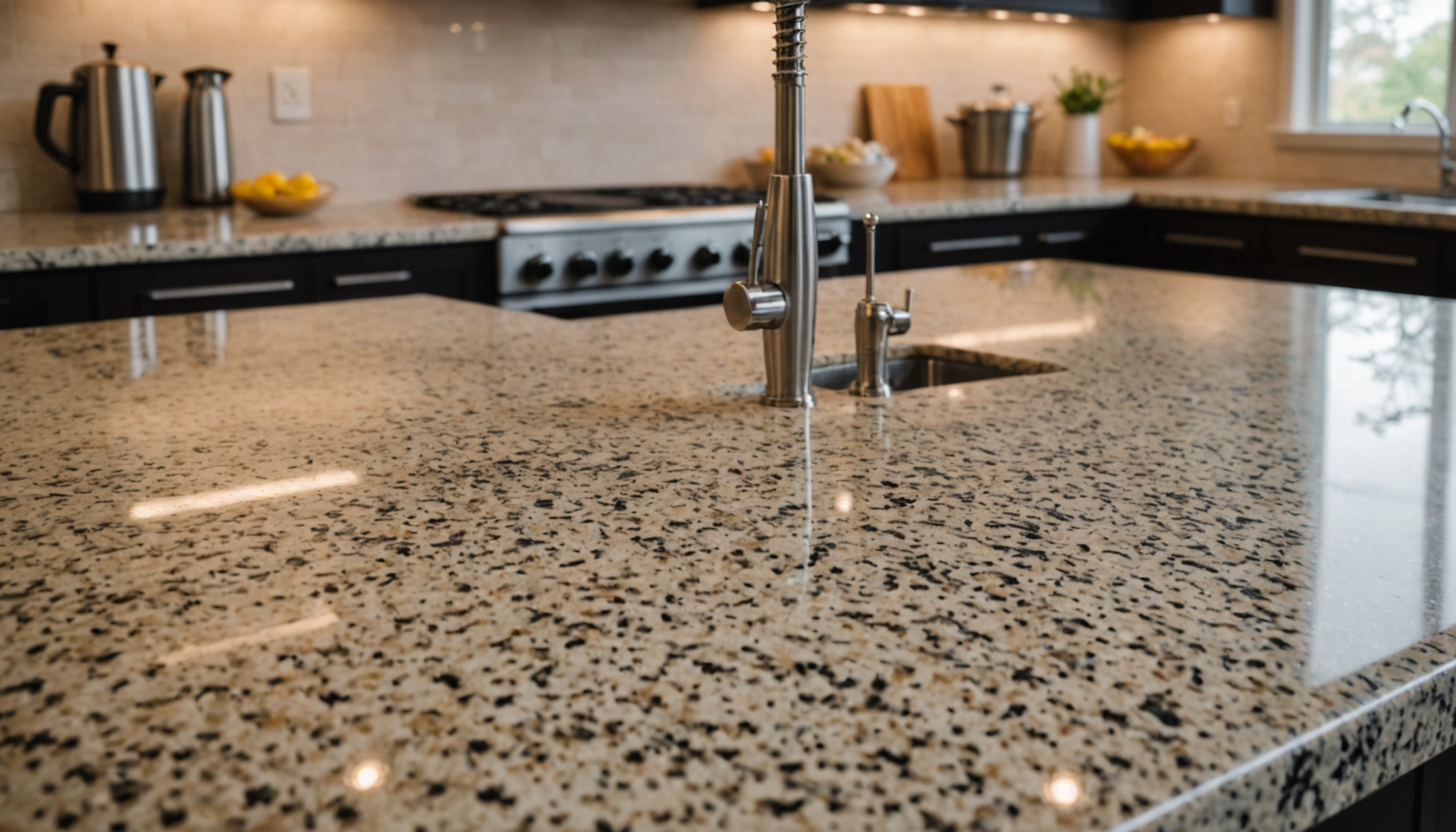When selecting kitchen countertops, the material you choose plays a significant role in aesthetics, functionality, and maintenance. There are a variety of countertop materials available, each with its unique advantages and disadvantages. Understanding these characteristics can help you make informed decisions that align with your lifestyle and kitchen use.
Natural stone countertops, such as granite and marble, offer unparalleled beauty and uniqueness as no two slabs are the same. Granite is renowned for its durability, heat resistance, and ability to withstand daily kitchen tasks. However, it does require periodic sealing to prevent stains and maintain its finish. Marble, on the other hand, is more porous and prone to staining and scratching but provides a classic, timeless look that is highly sought after.
For those seeking a more modern and sustainable option, engineered stone like quartz is an excellent choice. Quartz countertops are created by combining natural quartz with resins, making them non-porous and resistant to stains without the need for sealing. They are available in a wide range of colors and patterns, providing versatility in design.
Laminate countertops are a budget-friendly option that has increased in popularity due to advancements in design and technology. These countertops are constructed from plastic-coated synthetic materials pressed onto particleboard or kraft paper. While they are not as heat-resistant as natural stone, they offer an affordable and durable option for budget-conscious homeowners.
Wood countertops, often referred to as butcher block, bring warmth and a rustic feel to the kitchen. They are durable and can be sanded and resealed to maintain their appearance. However, wood requires regular maintenance to keep it in good condition, including oil treatments to prevent it from drying out. It’s also important to avoid excessive water exposure as this can lead to warping.
For a minimalist, industrial look, concrete countertops have become a trendy choice. They are durable and customizable but need to be sealed regularly to prevent stains and water damage. Concrete can develop hairline cracks over time, adding to its character, but may not be suitable for those who desire a pristine appearance.
In the contemporary kitchen, stainless steel countertops are celebrated for their hygienic properties and ability to withstand heat and corrosion. These are often found in professional kitchens due to their practicality but can scratch easily and show fingerprints more readily than other materials.
Below is a comparison table highlighting some key attributes of popular kitchen countertop materials to aid in your selection:
| Material | Durability | Maintenance Needs | Heat Resistance | Stain Resistance | Cost |
| Granite | High | Periodic sealing | Excellent | Good with sealing | Mid to High |
| Marble | Moderate | Frequent sealing | Good | Poor | High |
| Quartz | High | Low | Good | Excellent | Mid to High |
| Laminate | Moderate | Minimal | Poor | Moderate | Low |
| Wood | Moderate | Regular oiling | Poor | Poor | Low to Mid |
| Concrete | High | Sealing required | Good | Poor without sealant | Mid |
| Stainless Steel | High | Low | Excellent | Excellent | High |
Ultimately, the choice of kitchen countertop material depends on your personal style, budget, and the amount of time you’re willing to invest in maintenance. Balancing these factors will help ensure that your countertops not only complement your kitchen design but also serve as practical, lasting investments in your home.
cleaning methods for common stains
Dealing with stains on your kitchen countertops can be a daunting task, especially when faced with a variety of materials that require different cleaning approaches. Here’s a guide to help you effectively address common stains:
- Granite Countertops:
- Oil-Based Stains – Mix baking soda with water to form a paste. Apply it directly to the stain and cover with plastic wrap. Let it sit for 24 hours before wiping clean with a damp cloth.
- Organic Stains (coffee, tea) – Mix baking soda with hydrogen peroxide to form a paste. Apply it to the stain, cover with plastic wrap, and leave overnight. Rinse thoroughly with water.
- Marble Countertops:
- Acidic Stains (wine, lemon) – Sprinkle baking soda over the stain and spray with water to dampen. Cover with plastic wrap and let it sit for a few hours before wiping away.
- General Stains – Use a soft cloth with warm, soapy water. Avoid scrubbing as marble can scratch easily.
- Quartz Countertops:
- Ink or Permanent Marker – Apply a small amount of a non-abrasive glass or surface cleaner to a wet cloth and gently rub the stain in a circular motion.
- Grease Stains – Use a degreasing cleaner and follow with a warm, damp cloth to rinse.
- Laminate Countertops:
- General Stains – Use a solution of mild detergent and water. For stubborn stains, baking soda can be applied gently as laminate is prone to scratching.
- Ink Stains – Dab with a cloth soaked in rubbing alcohol, being careful to avoid excessive scrubbing.
- Wood Countertops:
- Water Rings – Place a dry cloth over the ring and gently iron the area with a medium-hot iron for a few seconds to release the moisture.
- General Stains – Mix salt and water to create a mildly abrasive paste. Scrub lightly and wipe off with a damp cloth.
- Concrete Countertops:
- Grease or Oil Stains – Spread cat litter or a similar absorbent material over the stain, let it sit overnight, and sweep away.
- General Stains – Use a pH-neutral cleaner with a soft scrub pad, avoiding harsh chemicals which can damage sealants.
- Stainless Steel Countertops:
- Water Spots – Use a cloth dampened with a solution of vinegar and water to remove spots, then dry with a towel to prevent further marks.
- Rust Spots – Mix baking soda with a small amount of water to form a paste. Gently rub with a soft cloth along the grain of the steel.
Remember, prevention is key when it comes to stains. Always wipe up spills as soon as they occur and avoid letting liquids sit on your countertops for extended periods. Regular maintenance will help keep your kitchen surfaces looking their best.
tips for preventing damage
One of the most effective ways to ensure your kitchen countertops remain in pristine condition is by taking proactive measures to prevent damage. Whether it’s avoiding unsightly scratches or protecting against heat damage, implementing certain habits and precautions is essential.
Start by using cutting boards for food preparation instead of slicing directly on the countertop, as this can guard against scratches and knife marks. For those who love incorporating vibrant colors into their cooking, it’s wise to also use trivets or hot pads under pans and dishes straight from the stove or oven. Exposing countertops to high temperatures can result in irreversible damage, especially on materials like laminate, which are particularly sensitive to heat.
Another crucial aspect of preventing damage to your countertops is being mindful of the types of cleaners you use. Many commercial cleaners, especially those with strong chemicals or abrasives, can degrade the surface and wear down any sealants applied to protect it. Instead, opt for gentle, pH-neutral cleansers and always read labels to ensure they’re compatible with your countertop material. Harsh chemicals are particularly detrimental to natural stone surfaces, which can absorb them and lose their protective finish over time.
Avoid placing acidic foods or substances in direct contact with materials such as marble, which is sensitive to acid etching. When spills happen, especially from acidic sauces or drinks, prompt clean-up with a soft cloth can significantly reduce the risk of permanent etching and staining. For wood countertops, consider applying mineral oil or beeswax regularly to keep the surface conditioned and resilient against water damage and warping.
Moreover, periodic sealing can go a long way in preserving the integrity of your countertops, particularly for porous materials like granite and marble. Ensuring your countertops are properly sealed helps to repel stains and moisture, which are common culprits in causing long-term damage.
Finally, being diligent with your cleaning routine and using coasters for beverages will further protect surfaces from unsightly water rings and residue build-up. These simple, yet effective practices not only help maintain the aesthetic appeal and longevity of your countertops but also enhance your overall kitchen experience by keeping it a safe and beautiful environment for all your culinary adventures.
sealing and maintenance routines
Regularly sealing your kitchen countertops is a critical step in maintaining their durability and appearance, particularly for porous materials like granite, marble, and concrete. The process of sealing is designed to protect the surface from absorbing liquids and suffering from stains and etching, thereby extending the life of your countertops.
To seal your countertops effectively, begin by ensuring the surface is thoroughly cleaned and free of any residues or food particles. It’s essential to use products that are specifically formulated for your countertop material to avoid any adverse reactions. Once your countertop is clean and dry, apply the sealer evenly with a clean, soft cloth, sponge, or applicator pad, following the manufacturer’s instructions carefully. Pay special attention to the edges and corners, as these areas can often be overlooked but are equally susceptible to damage.
After applying the sealer, allow it to penetrate and cure according to the product guidelines. This typically involves letting it sit for a designated period, usually around 15-30 minutes, before wiping off any excess. Some sealers may require multiple applications to achieve the best results, particularly in areas that see frequent use.
Maintenance routines should complement your sealing efforts. Regular routines include wiping down your countertop daily with a damp microfiber cloth and a pH-balanced cleaner to remove dust, grime, and bacteria effectively. This easy, everyday step prevents the buildup that can lead to tougher stains, reducing the frequency of more intensive cleanings.
Consider periodically conducting a water test to check the effectiveness of your sealer. Simply sprinkle a few drops of water on the surface; if the water beads up, your sealer is still doing its job. If it soaks into the surface, it’s time to reapply the sealant. For those materials that require it, sealing should typically occur every 1 to 2 years, although high-traffic kitchens might necessitate more frequent attention.
For non-porous surfaces like quartz or stainless steel, which typically don’t require sealing, focus on preserving their sheen and resistance through regular, gentle cleaning and polishing. Use specific products designed for these materials to enhance their natural protective properties and avoid scratches or dulling over time.
By establishing a diligent sealing and maintenance regimen, you can significantly enhance the longevity and aesthetic appeal of your kitchen countertops, ensuring they serve as both a durable and stylish element of your space for years to come. Remembering to perform regular assessments and stay informed about the proper care techniques specific to your countertop material ensures that they remain a stunning feature in your home.
eco-friendly cleaning solutions
Embracing eco-friendly cleaning solutions is not only beneficial for the environment but also more conducive to maintaining the longevity of your kitchen countertops. Begin by utilizing natural ingredients like vinegar, baking soda, and lemon juice, which are not only effective at cutting through grease and grime but also safe for a variety of surfaces.
For marble and granite, a basic solution of warm water and a few drops of dish soap is ideal for regular cleaning. Avoid using vinegar and lemon directly on these surfaces, as their acidity can degrade the stone over time. For a more sustainable approach, mix a small amount of castile soap with water in a spray bottle for an all-purpose cleaning solution that’s gentle on your countertop and the planet.
Lemon juice is effective for cutting through grease on stainless steel countertops and also leaves a fresh scent. Ensure thorough rinsing after use to prevent any potential etching, and dry with a soft, microfiber cloth to avoid water spots.
Baking soda serves as a mild abrasive that can be employed for tackling stubborn stains on concrete or laminate countertops. To use, make a paste with water, apply it to the stain, let it sit for a few minutes, then gently scrub before rinsing with water. This environmentally friendly alternative provides cleaning power without introducing harmful chemicals into your home.
Don’t overlook the use of essential oils for both their cleaning and aromatic properties. A few drops of tea tree oil mixed with water can act as a disinfectant for wood countertops, keeping them fresh and sanitized without compromising their natural beauty. Just be sure to apply a conditioner like beeswax afterward to keep the wood from drying out.
For those who prefer ready-made solutions, consider buying eco-friendly cleaners that are biodegradable and free from synthetic fragrances, dyes, and harsh chemicals. These are widely available and designed to work in harmony with your home and the environment, making them a smart choice for conscientious cleaning.
By adopting these green cleaning practices, you not only contribute to a healthier home environment but also protect your countertops from potential damage caused by harsh chemicals, ensuring they remain vibrant and functional elements of your kitchen for years to come.
—
Caring for your kitchen countertops involves understanding the specific needs of the materials you’ve chosen, from selecting the right cleaning methods to performing routine maintenance. By combining preventive measures with proper sealing and eco-friendly cleaning solutions, you can preserve their beauty and functionality. Commitment to these practices extends the life of your countertops, supporting a sustainable kitchen environment and enhancing your culinary experience.


